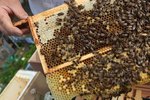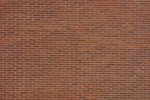Hornets typically prefer to stay away from humans, and won't attack unless they feel threatened. They consider disturbing of the nest a serious threat, so you should avoid them as best you can. Hornet nests have a distinct shape and texture that make them easy to identify, even when their inhabitants aren't around.
Presence of Hornets
One of the easiest ways to identify a hornet nest is to identify the insects swarming around it. Hornets are distinctly different in appearance from insects like bumble bees, though they have stingers and stripes in common. The most common species, baldfaced hornets, have white faces with black-and-white-striped bodies. European hornets, on the other hand, are reddish-brown, with noticeably hairy bodies.
Paper Nests
A hornet nest looks distinctly like it's made of paper, and with good reason -- it's actually made out of saliva and wood pulp. Hornets strip wood from trees, mixing the ground fibers with their saliva to form the grayish-brown pulp that forms the nest. The final result is a large nest -- larger than a football -- that looks like a honeycomb loosely wrapped in thick sheets of paper.
Nesting Locations
You can also identify the hornet nest based on where you find it. Hornets prefer to build their nests in secluded, highly visible places -- most commonly, out in the open in a tree. In urban areas, they may be forced to build their nests in closer proximity to humans, like in shrubbery, around a chimney or underneath the outcropping of a building. Unlike bees who may build their colonies inside walls, or yellow jackets who may build nests underground, hornets always build their nests out in the open where you can see them.
Identifying Old Nests
Hornets build new nests every year, leaving behind the old ones. This means that the hornet nest you find may be abandoned and can be easily removed. Hornets start building their nests in the spring; if you find a fully developed nest in spring -- one that is larger than a football -- it is likely left over from the previous year. As a new nest slowly grows, it attracts more and more hornets, who continue building it throughout spring and early summer.
References
Writer Bio
Tom Ryan is a freelance writer, editor and English tutor. He graduated from the University of Pittsburgh with a degree in English writing, and has also worked as an arts and entertainment reporter with "The Pitt News" and a public relations and advertising copywriter with the Carnegie Library of Pittsburgh.




